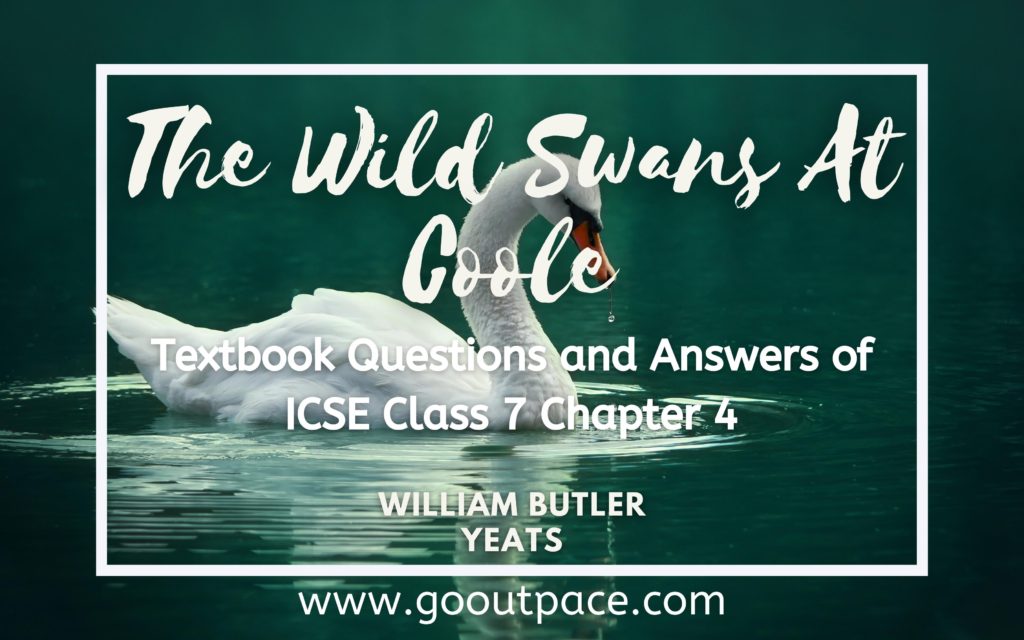You will go through Textbook Questions And Answers Of ICSE Board Class 7 The Wild Swans At Coole Chapter 4 written by William Butler Yeats. Understanding a text’s entirety is very important for a learner to score better in the exam. Efforts have been made to ensure a thorough and proper Textbook Questions And Answers Of ICSE Board Class 7 The Wild Swans At Coole Chapter 4 was written by William Butler Yeats.

A. Write whether the statements are true (T) or false (F):
- It was spring when the poet saw the swans. (F)
- The poet saw them in the month of October at dawn. (F)
- The poet counted fifty swans. (F)
- The poet had visited the lake before. (T)
- The swans’ hearts have grown old with time. (F)
- Opportunities for passion and conquest still wait for the swans. (T)
THE WILD SWANS AT COOLE – CHAPTER 4 TEXTBOOK SOLUTIONS
‘Under the October twilight the water
Mirrors a still sky…’
a. Which water is being spoken about in these lines? Identify the figure of speech and explain it in your own words.
b. What did the poet see immediately after this? Where did he see them?
c. How had the poet described the land around the lake in the previous lines?
d. How is the land and the lake contrasted?
Ans: a. The poet is referring to the water of Coole Park in Ireland.
The figure of speech used is personification. Here an inanimate object (water) is attributed a human nature.
b. The poet immediately saw fifty-nine swans upon the overflowing water at Coole Park.
c. The poet has referred to the land around the lake as woodlands. Unlike the lake, the woodlands are dry in the autumn.
d. The lake is overflowing with water, whereas the land around is just dry. The swans in the lake also symbolise hope and compassion.
THE WILD SWANS AT COOLE – CHAPTER 4 TEXTBOOK SOLUTIONS
‘The nineteenth autumn has come upon me
Since I first made my count…’
a. How old had the poet been when he had first seen the swans?
b. What did the swans do as the poet was counting them?
c. Which word in the stanza means ‘a circular motion’? Did the swans rise into the sky together? Quote the line in the stanza which indicates it.
Ans: a. The poet had come to the lake and had counted the swans around nineteen years back.
b. Before the poet could finish counting, the swans rose into the air to fly away. They all flapped their wings together and it made bell-like sounds.
c. The word “wheeling” means “a circular motion”. The swans rose into the sky together. The line that indicates it is:
“All suddenly mount
And scatter wheeling in great broken rings
Upon their clamorous wings.”
THE WILD SWANS AT COOLE – CHAPTER 4 TEXTBOOK SOLUTIONS
‘I have looked upon those brilliant creatures,
And now my heart is sore’
a. How was the poet feeling at this time? Why do you think he felt this way?
b. How had the poet changed since the first time he had seen the swans? What does it indicate?
c. How does the poet go on to explain that the swans have not changed?
Ans: a. The poet feels upset. He uses the term “sore” to express his feelings.
The reason that the poet was feeling sore when he saw the swans could be anything. It could be the realisation that the swans had so much compassion and were carefree, unlike the poet. The reason could also be that the swans were “brilliant creatures”, and the poet was envious.
b. The poet says that everything has changed since he had seen the swans for the first time. He “trod with a lighter tread”. This means that he had less responsibilities then and did not have so much baggage as he had during the time when he wrote this poem.
c. The poet compares the sound of their wings flapping together to bells. This denotes a concept of how time passes by. These beautiful birds made the same sound years back when the poet first saw them. They do the same after nineteen years. Also, swans are believed to mate for life. There is a sense of eternity and foreverness in these birds
THE WILD SWANS AT COOLE – CHAPTER 4 TEXTBOOK SOLUTIONS
What do the swans symbolise in the poem?
Ans: The swans in the poem symbolise eternity, hope, compassion, and foreverness.
From the second to the last stanza, the poet describes the movement of the swans as they take off from the lake, fly in the air, or swim in the water. Quote these lines and explain them.
Ans: Swans take off: “All suddenly mount
And scatter wheeling in great broken rings
Upon their clamorous wings.”
These lines denote that the swans rose into the sky together.
They fly in the air: “The bell-beat of their wings above my head…”
The poet compares the sound of their wings flapping together to bells. This denotes a concept of how time passes by. These beautiful birds made the same sound years back when the poet first saw them.
Swim in the water: “Unwearied still…
They paddle in the cold”
The poet says that the swans are still not tired, and they are paddling their way in the cold water.
Identify the rhyme scheme:
1. He gives his harness bells a shake
To ask if there is some mistake.
The only other sound’s the sweep
Of easy wind and downy flake
Ans: aaba.
2. The sun was shining on the sea,
Shining with all his might:
He did his very best to make
The billows smooth and bright-
And this was odd, because it was
The middle of the night.
Ans: abcbdb.
Explain these lines in your own words:
Now they drift on the still water.
Ans: They (swans) were not moving or paddling in the water. They were in a relaxed position on the still water.
The swans delight men’s eyes.
Ans: The swans are beautiful and brilliant creatures. They would go away or wonder around and impress someone else.
This is the nineteenth summer of my life.
Ans: This is the nineteenth year of my life.
They paddle in the cold companionable streams.
Ans: The sense of companionship makes the cold water more tolerable. The swans have each other’s company, and this is how they keep paddling in the cold streams.
The birds climb the air.
Ans: The birds raise into the air to fly.


